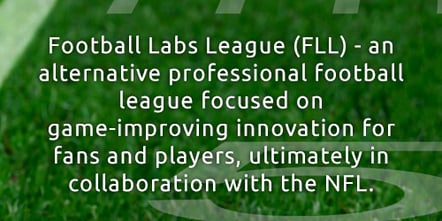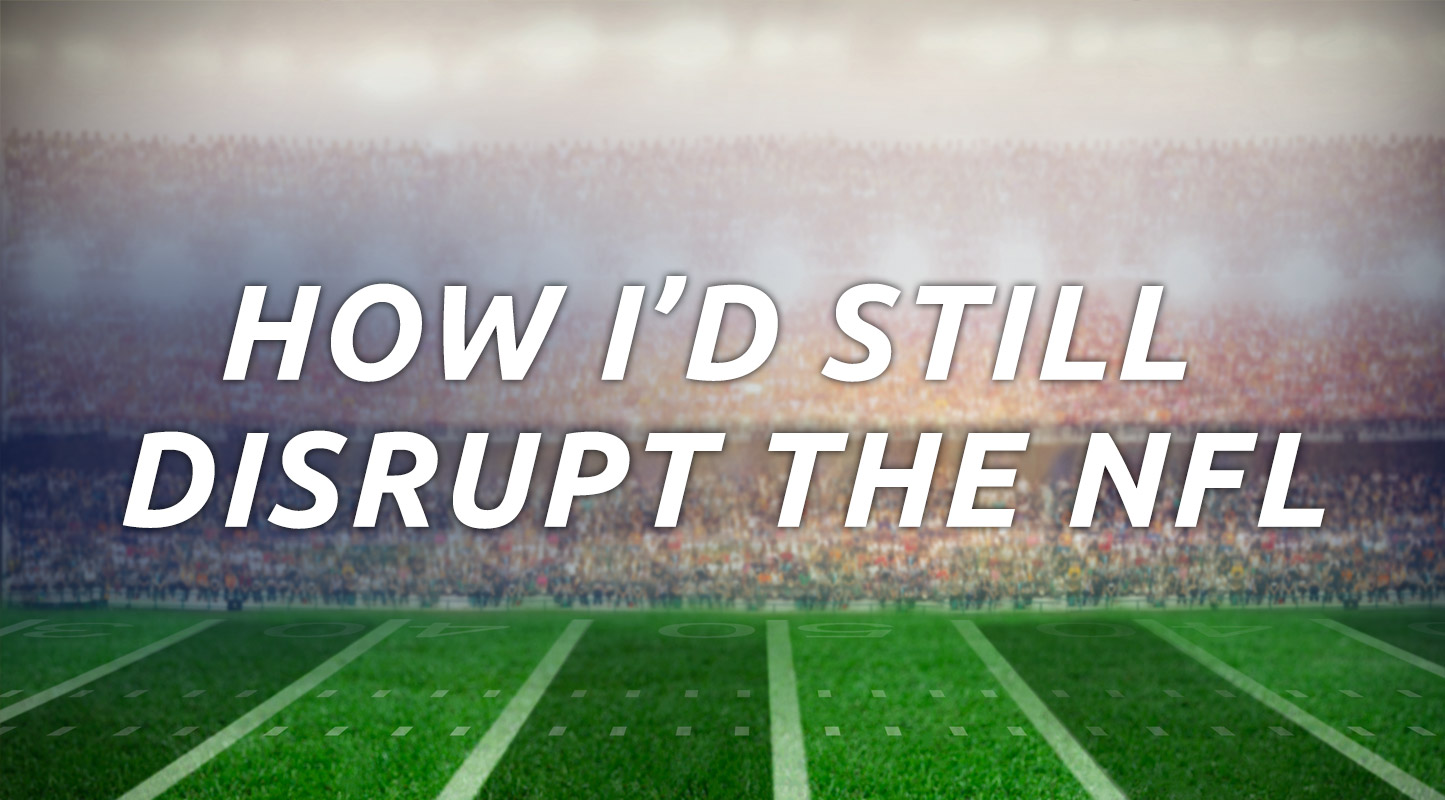Sep 17, 2019 How I’d Still Disrupt the NFL
By Ryan Keintz
The NFL disruption opportunity I highlighted a few years ago is still ripe for the picking. One adversarial competitor, the AAF, has already since come and gone, while the XFL is on the way, again. Neither have shown the right disruptive strategy or significant innovation to viably compete with the NFL. I have a different vision, but unfortunately I do not have the bankroll to make it happen. So someone kindly put this in front of Mark Cuban or Lebron.
So here’s the mission: Create an alternative professional football league focused on game-improving innovation, serving as an experimentation laboratory for testing ideas and demonstrating proof of concept. For reference, I’ll call this hypothetical the Football Labs League (FLL).
 The NFL isn’t recognizing this opportunity themselves, or perhaps their innovation tolerance is limited by not wanting to mess with what’s working. That’s what startups are for! In a previous article We’re Not Uber, I introduced the concept of collaborative disruption. Whereas Uber assaulted the traditional taxi industry head-on, disruption partners collaborate with the existing industry stakeholders to create a bridge to the future – a future which includes industry incumbents. This model would work for disrupting the NFL in partnership with the NFL. That said, the mobility industry was reluctant to partner with PricePoint in our earlier years. The NFL would likewise not be an expected partner from the outset.
The NFL isn’t recognizing this opportunity themselves, or perhaps their innovation tolerance is limited by not wanting to mess with what’s working. That’s what startups are for! In a previous article We’re Not Uber, I introduced the concept of collaborative disruption. Whereas Uber assaulted the traditional taxi industry head-on, disruption partners collaborate with the existing industry stakeholders to create a bridge to the future – a future which includes industry incumbents. This model would work for disrupting the NFL in partnership with the NFL. That said, the mobility industry was reluctant to partner with PricePoint in our earlier years. The NFL would likewise not be an expected partner from the outset.
The launch focal points of the Labs League experimentation would be 1) player safety and 2) simplification of rules. In my opinion, these are two important areas which the NFL is failing to adequately address and is consequently harming their own product value.
Simplification of rules
The NFL keeps tripping itself up with its own ever-increasingly complex rule book, which I believe results in a poor officiating and less enjoyable games. This includes the ongoing micro-management of what qualifies as a catch, and new 2019 territory of subjecting pass interference (non)calls to game-delaying video reviews. People, when it comes to rules, less is more (see Household Goods Audits and Their Unintended Consequences and Are You Aware of the Costs You Create for Your Suppliers? ).
As demonstration of how exceedingly complex rules damages product value, I submit the Dez Bryant catch reversal, and if possible have it start at 0:36> in the 2014 playoffs. Late in a dramatic fourth quarter, Dez made a catch which positioned the Dallas Cowboys to defeat the Green Bay Packers. To any reasonable person observing in real time or slow-motion, Dez caught the ball, period. What he didn’t do is “maintain possession while going to the ground” or “make a football move” after catching the ball. Nor did he also take out the garbage and do his taxes, which are equally relevant. He caught it! Hooray, drama, excitement! But no, the NFL must stop everything and take out their protractors for a few minutes, ultimately to conclude that Dez did not properly complete the catch application process, so catch nullified. If Bryant’s clutch catch were allowed, it would be a highlight for the ages, and the ball would have consequently been put back into Aaron Rodgers’ hands for a dramatic fourth quarter finish. Instead the game ended with anti-climactic kneel-downs. The NFL rule book produced a less entertaining product, SMH.
The rule book complexity is also creating human officiating errors. NFL game officials are absurdly expected to evaluate evermore nuances in lighting fast real-time, or game-slowing review. Penalty flags aren’t fun, and trivial infractions frequently erase great plays and disrupt the flow of the game.
Football Labs would treat the rule book like software code, focusing on elegance and efficiency, less is more. Using catches as example, the FLL rule book would simply state “A catch is control of the ball with two feet in-bounds.” That’s all, no extraneous qualifiers. If two feet with ball control is demonstrated for even a nano-second, it’s a catch and live ball. Why over-complicate it? There are a variety of areas where the game could be re-balanced and improved by a focus on rule simplification. Pre-snap procedural penalties could also be slashed in frequency, but I digress.
Player Safety
Here’s where the experimentation gets a bit more radical, and important. But first let me address the elephant in the room: because of concussion concerns, I will discourage my sons from playing organized football, and I expect millions of parents feel the same way. This is obviously a long-term threat to the future of the game. If I were the NFL, I would have already very publicly pledged $1 billion to concussion R&D. I’m not the NFL, so here’s the FLL approach…
The core innovation is to remove the act of tackling to the ground as the primary means of ending a play. Consider that a small percentage of NFL plays are currently ended by a whistle blown for forward progress being stopped rather than tackling to the ground. The idea is to inverse that ratio – using technology – so that tackling to the ground becomes the exception rather than the norm.
Before explaining the tech component, consider the following:
- A significant portion of injuries occur from the violence of impacting the ground, often with hundreds of pounds of players landing on top of each other and forcing joints beyond their range of motion, sometimes gruesomely. All-too-frequent injuries to star players also harms product value.
- Merely removing the tackle requirement would tone-down game physics, in a good way. Currently when a 250 lb running back comes bursting through the line, a defensive player needs to generate enough violent opposing force to not only stop the player, but to bring him to the ground.
So what if the defense merely needed to stop the player’s forward progress, rather than fully tackle? Seems to me this would reduce inertia on both sides of the ball, which would inherently reduce concussions and other injuries, and put more emphasis on athleticism than violent brute force. You might be thinking, “But you just said we should simplify the rules. Wouldn’t this put far more judgement calls in the hands of the officials to whistle plays dead?” No, because this is where the tech comes in and further enhances the game.
I envision a sensor system integrated into game and player equipment consisting of accelerometers and proximity detectors (maybe some MIT/Stanford involvement with NFL concussion research funding?). These sensors could be calibrated to automatically regulate the end of plays via some combined threshold of stopping forward progress and proximity of defender(s). For example, let’s say if a single defensive player is grasping the ball carrier and stops their forward progress for one full second, the sensors would visibly and audibly signal the end of the play. If more than one defender is within “graspable proximity”, it proportionally reduces the time requirement, e.g. 1 defender for 1 second, 2 defenders for 0.5 seconds, etc.
I’ve played enough backyard and organized football to believe that the core athleticism and physicality of the game can be maintained, while reducing the injury and concussion-causing extremes. As a side note, I also love how the sensors and play-ending signals could be integrated directly into the televised on screen experience, much like the superimposed first down markers. The tech-supported drama would be outstanding. Imagine watching a goal-line rugby scrum while hoping/dreading that the in-game sensors will suddenly illuminate the screen with TOUCHDOWN! or STOPPED!
Business Strategy
Back to the whole disruptive angle, I see the new FLL launching as a separate entity which is eventually acquired by the NFL. Again, the idea is not to compete with the NFL, but to complement the NFL and experiment with game-improving innovations that the NFL is unwilling or unable to undertake itself for a variety of reasons. As collaboration grows, the FLL could serve as testing grounds for further experimentation put forth by the NFL Competition Committee. The FLL could also nicely fill a void as a minor-league player development area for the NFL, and even disrupt the unpaid player scam of the NCAA. Imagine the value proposition to high-school grad football players and parents: Not only will you get paid, but the FLL is at the forefront of player safety.
In my experience, collaborative disruption can come from a startup that has deep industry experience, but establishes itself as an independent entity, not beholden to potential legacy conflicts of interest. It must then achieve proof-of-concept milestones to demonstrate viability to industry incumbents and articulate a win/win vision and strategy. I was more or less able to pull this off as a garage startup in the moving industry, but the FLL may require a billion dollar buy-in from Day 1. So I’m submitting this idea as open source. Someone please do it.
Founder and President. After a career pricing for the largest international movers, Ryan observed that price manipulation was a more critical success factor than customer service or logistical expertise. He created PricePoint to fix a broken system.

